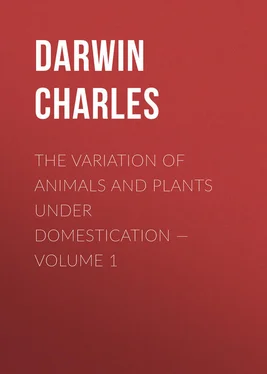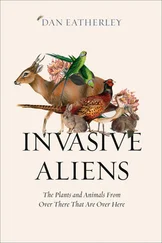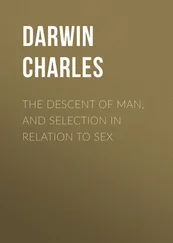Charles Darwin - The Variation of Animals and Plants under Domestication — Volume 1
Здесь есть возможность читать онлайн «Charles Darwin - The Variation of Animals and Plants under Domestication — Volume 1» — ознакомительный отрывок электронной книги совершенно бесплатно, а после прочтения отрывка купить полную версию. В некоторых случаях можно слушать аудио, скачать через торрент в формате fb2 и присутствует краткое содержание. Жанр: foreign_antique, foreign_prose, на английском языке. Описание произведения, (предисловие) а так же отзывы посетителей доступны на портале библиотеки ЛибКат.
- Название:The Variation of Animals and Plants under Domestication — Volume 1
- Автор:
- Жанр:
- Год:неизвестен
- ISBN:нет данных
- Рейтинг книги:5 / 5. Голосов: 1
-
Избранное:Добавить в избранное
- Отзывы:
-
Ваша оценка:
- 100
- 1
- 2
- 3
- 4
- 5
The Variation of Animals and Plants under Domestication — Volume 1: краткое содержание, описание и аннотация
Предлагаем к чтению аннотацию, описание, краткое содержание или предисловие (зависит от того, что написал сам автор книги «The Variation of Animals and Plants under Domestication — Volume 1»). Если вы не нашли необходимую информацию о книге — напишите в комментариях, мы постараемся отыскать её.
The Variation of Animals and Plants under Domestication — Volume 1 — читать онлайн ознакомительный отрывок
Ниже представлен текст книги, разбитый по страницам. Система сохранения места последней прочитанной страницы, позволяет с удобством читать онлайн бесплатно книгу «The Variation of Animals and Plants under Domestication — Volume 1», без необходимости каждый раз заново искать на чём Вы остановились. Поставьте закладку, и сможете в любой момент перейти на страницу, на которой закончили чтение.
Интервал:
Закладка:
That there has been much inherited variation in the horse cannot be doubted, when we reflect on the number of the breeds existing throughout the world or even within the same country, and when we know that they have largely increased in number since the earliest known records. (2/10. Godron, 'De l'Espece' tome 1 page 378.) Even in so fleeting a character as colour, Hofacker (2/11. 'Ueber die Eigenschaften' etc. 1828 s. 10.) found that, out of 216 cases in which horses of the same colour were paired, only eleven pairs produced foals of a quite different colour. As Professor Low (2/12. 'Domesticated Animals of the British Islands' pages 527, 532. In all the veterinary treatises and papers which I have read, the writers insist in the strongest terms on the inheritance by the horse of all good and bad tendencies and qualities. Perhaps the principle of inheritance is not really stronger in the horse than in any other animal; but, from its value, the tendency has been more carefully observed.) has remarked, the English race-horse offers the best possible evidence of inheritance. The pedigree of a race-horse is of more value in judging of its probable success than its appearance: "King Herod" gained in prizes 201,505 pounds sterling, and begot 497 winners; "Eclipse" begot 334 winners.
Whether the whole amount of difference between the various breeds has arisen under domestication is doubtful. From the fertility of the most distinct breeds (2/13. Andrew Knight crossed breeds so different in size as a dray-horse and Norwegian pony: see A. Walker on 'Intermarriage' 1838 page 205.) when crossed, naturalists have generally looked at all the breeds as having descended from a single species. Few will agree with Colonel H. Smith, who believes that they have descended from no less than five primitive and differently coloured stocks. (2/14. 'Nat. Library, Horses' volume 12 page 208.) But as several species and varieties of the horse existed (2/15. Gervais 'Hist. Nat. Mamm.' tome 2 page 143. Owen 'British Fossil Mammals' page 383.) during the later tertiary periods, and as Rutimeyer found differences in the size and form of the skull in the earliest known domesticated horses (2/16. 'Kenntniss der fossilen Pferde' 1863 s. 131.), we ought not to feel sure that all our breeds are descended from a single species. The savages of North and South America easily reclaim the feral horses, so that there is no improbability in savages in various quarters of the world having domesticated more than one native species or natural race. M. Sanson (2/17. 'Comptes rendus' 1866 page 485 and 'Journal de l'Anat. et de la Phys.' Mai 1868.) thinks that he has proved that two distinct species have been domesticated, one in the East, and one in North Africa; and that these differed in the number of their lumbar vertebra and in various other parts; but M. Sanson seems to believe that osteological characters are subject to very little variation, which is certainly a mistake. At present no aboriginal or truly wild horse is positively known to exist; for it is commonly believed that the wild horses of the East are escaped domestic animals. (2/18. Mr. W.C.L. Martin, 'The Horse' 1845 page 34, in arguing against the belief that the wild Eastern horses are merely feral, has remarked on the improbability of man in ancient times having extirpated a species in a region where it can now exist in numbers.) If therefore our domestic breeds are descended from several species or natural races, all have become extinct in the wild state.
With respect to the causes of the modifications which horses have undergone, the conditions of life seem to produce a considerable direct effect. Mr. D. Forbes, who has had excellent opportunities of comparing the horses of Spain with those of South America, informs me that the horses of Chile, which have lived under nearly the same conditions as their progenitors in Andalusia, remain unaltered, whilst the Pampas horses and the Puno horses are considerably modified. There can be no doubt that horses become greatly reduced in size and altered in appearance by living on mountains and islands; and this apparently is due to want of nutritious or varied food. Every one knows how small and rugged the ponies are on the Northern islands and on the mountains of Europe. Corsica and Sardinia have their native ponies; and there were (2/19. 'Transact. Maryland Academy' volume 1 part 1 page 28.), or still are, on some islands on the coast of Virginia, ponies like those of the Shetland Islands, which are believed to have originated through exposure to unfavourable conditions. The Puno ponies, which inhabit the lofty regions of the Cordillera, are, as I hear from Mr. D. Forbes, strange little creatures, very unlike their Spanish progenitors. Further south, in the Falkland Islands, the offspring of the horses imported in 1764 have already so much deteriorated in size (2/20. Mr. Mackinnon 'The Falkland Islands' page 25. The average height of the Falkland horses is said to be 14 hands 2 inches. See also my 'Journal of Researches.') and strength that they are unfitted for catching wild cattle with the lasso; so that fresh horses have to be brought for this purpose from La Plata at a great expense. The reduced size of the horses bred on both southern and northern islands, and on several mountain-chains, can hardly have been caused by the cold, as a similar reduction has occurred on the Virginian and Mediterranean islands. The horse can withstand intense cold, for wild troops live on the plains of Siberia under lat. 56 deg, (2/21. Pallas 'Act. Acad. St. Petersburgh' 1777 part 2 page 265. With respect to the tarpans scraping away the snow see Col. Hamilton Smith in 'Nat. Lib.' volume 12 page 165.) and aboriginally the horses must have inhabited countries annually covered with snow, for he long retains the instinct of scraping it away to get at the herbage beneath. The wild tarpans in the East have this instinct; and so it is, as I am informed by Admiral Sulivan, with the horses recently and formerly introduced into the Falkland Islands from La Plata, some of which have run wild; this latter fact is remarkable, as the progenitors of these horses could not have followed this instinct during many generations in La Plata. On the other hand, the wild cattle of the Falklands never scrape away the snow, and perish when the ground is long covered. In the northern parts of America the horses descended from those introduced by the Spanish conquerors of Mexico, have the same habit, as have the native bisons, but not so the cattle introduced from Europe. (2/22. Franklin 'Narrative' volume 1 page 87 note by Sir J. Richardson.)
The horse can flourish under intense heat as well as under intense cold, for he is known to come to the highest perfection, though not attaining a large size, in Arabia and northern Africa. Much humidity is apparently more injurious to the horse than heat or cold. In the Falkland Islands, horses suffer much from the dampness; and this circumstance may perhaps partly account for the singular fact that to the eastward of the Bay of Bengal (2/23. Mr. J.H. Moor 'Notices of the Indian Archipelago' Singapore 1837 page 189. A pony from Java was sent ('Athenaeum' 1842 page 718) to the Queen only 28 inches in height. For the Loo Choo Islands, see Beechey 'Voyage' 4th. edition volume 1 page 499.), over an enormous and humid area, in Ava, Pegu, Siam, the Malayan archipelago, the Loo Choo Islands, and a large part of China, no full-sized horse is found. When we advance as far eastward as Japan, the horse reacquires his full size. (2/24. J. Crawfurd, 'History of the Horse' 'Journal of Royal United Service Institution' volume 4.)
With most of our domesticated animals, some breeds are kept on account of their curiosity or beauty; but the horse is valued almost solely for its utility. Hence semi-monstrous breeds are not preserved; and probably all the existing breeds have been slowly formed either by the direct action of the conditions of life, or through the selection of individual differences. No doubt semi-monstrous breeds might have been formed: thus Mr. Waterton records (2/25. 'Essays on Natural History' 2nd series page 161.) the case of a mare which produced successively three foals without tails; so that a tailless race might have been formed like the tailless races of dogs and cats. A Russian breed of horses is said to have curled hair, and Azara (2/26. 'Quadrupedes du Paraguay' tome 2 page 333. Dr. Canfield informs me that a breed with curly hair was formed by selection at Los Angeles in North America.) relates that in Paraguay horses are occasionally born, but are generally destroyed, with hair like that on the head of a negro; and this peculiarity is transmitted even to half-breeds: it is a curious case of correlation that such horses have short manes and tails, and their hoofs are of a peculiar shape like those of a mule.
Читать дальшеИнтервал:
Закладка:
Похожие книги на «The Variation of Animals and Plants under Domestication — Volume 1»
Представляем Вашему вниманию похожие книги на «The Variation of Animals and Plants under Domestication — Volume 1» списком для выбора. Мы отобрали схожую по названию и смыслу литературу в надежде предоставить читателям больше вариантов отыскать новые, интересные, ещё непрочитанные произведения.
Обсуждение, отзывы о книге «The Variation of Animals and Plants under Domestication — Volume 1» и просто собственные мнения читателей. Оставьте ваши комментарии, напишите, что Вы думаете о произведении, его смысле или главных героях. Укажите что конкретно понравилось, а что нет, и почему Вы так считаете.












